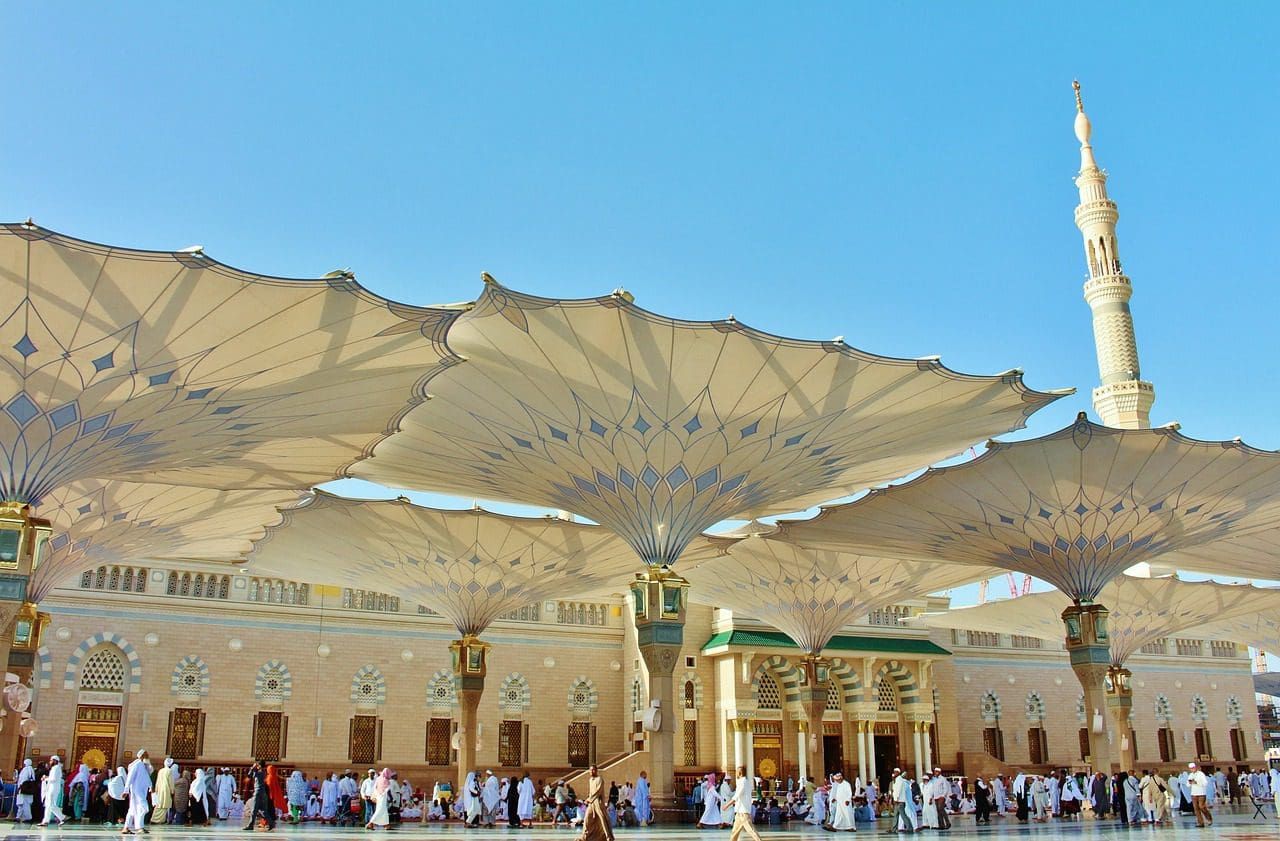Islam is an Abrahamic, Monotheistic, and the second-largest religion and faith in the world. It includes complete submission to God.
The followers of Islam are known as Muslims. The religion originates in the Arabian peninsula in Mecca and dates back to the early 7th century CE.
There are over 49 countries that are Muslim majority. Roughly around 62% of Muslims reside in parts of Asia, and about 20% of Muslims are Arabs.
Key Takeaways
- Sunni Muslims represent most of the Islamic population, whereas Ahmadis are a minority sect.
- Ahmadis believe Mirza Ghulam Ahmad was the Promised Messiah, while Sunni Muslims reject this claim.
- Ahmadi Muslims face persecution in some countries, primarily due to theological differences from Sunni Islam.
Sunni vs Ahmadi
The difference between Sunni and Ahmadi is in the belief in their Prophethood. Sunnis consider their final Prophet as Prophet Muhammad, while Ahmadis consider that their Prophet is supposed to come and will be known as Mirza Ghulam Ahmed of Qadin. This brings about the violation in Islam, which believes that Muhammad is the last Prophet.

The substantial denomination in Islam is Sunni Islam, which sums up about 85-90% of the total Muslim population. Sunnis are also popularly called Ahl as-Sunnah or Ahl as-Sunnah wa’l-Jama’h.
The name simply means “Followers Or Adherents to the Sunnah and the community”. The Sunnis are strict followers of the Holy Quran and the preachings of Prophet Muhammad in Hadith.
While tracing its roots to 19th century British India, Ahmadiyyas are an Islamic revival group.
The community was founded by Mirza Ghulam Ahmed, who is considered both the Messiah as well as the promised Mahdi ( also known as the guided one).
The Messiah is an eschatological figure who would appear towards the end times of a tough phase and establish the final triumph of Islam through peaceful means.
Comparison Table
| Parameters of Comparison | Sunni | Ahmadi |
|---|---|---|
| Belief about Prophet | Sunnis believes Prophet Muhammad to be the last Prophet. | Ahmadias believes that their last Prophet is Mirza Ghulam Ahmad. |
| Origin | Sunni schools of thought were founded in the early stages of Islam in the 7th century. | It was founded in British India in 1889. |
| Belief about Jesus | Sunnis hold the belief that Jesus never died and is living in the skies. | Ahmadiyyas hold the belief that Jesus has died and is buried in Kashmir. |
| Population | Sunnis account for about 80-90% for the population. | Ahmadiyyas are a minority and have a population of roughly about 10-20 million |
| Public Opinion | Compared to Ahmadiyyas, Sunnis are considered more orthodox and consider themselves as the people of the tradition. | Ahmadiyyas are largely considered as Non- Muslims by other sects of Islam and are subject to persecution and discrimination by other Islamic groups. |
What is Sunni?
Sunnis believe that the rightful successors to Muhammad are the first four caliphs, as their Almighty did not mention any specific leaders who could succeed him, and so the leaders were elected by the followers.
Sunnis hold the belief that for a person to be a Caliph, he should be righteous and uphold the teachings of their religion Islam, and be the ideal example and be like the Prophet Muhammad.
Sunni is the largest community of Islam.
The name is derived from the term “Sunnah”, which implies the behavioural characteristics of Muhammad.
Sunnis follow the Holy Quran as their authentic scriptures, written in the Sunni tradition. The followers of Sunni are known as Ahl as-Sunnah wa l-jamā’ah. Sunnis follow Islamic schools of thought.
The community is based on six pillars of imān. Some scholars consider Sunni Islam as “Orthodox Islam” mostly based on some inappropriate translation.
All Muslims test the validity and rationality of others and allow one to choose and follow anyone they find sound and agreeable.
Sunni schools of thought or theory are built on the foundation of Asharism, which was founded by Maturidi by Abu Mansur Al- Maturidi (780-855 CE), Al-Ashʿarī ( 874-936 CE), and theology of the traditionalist, which is under the leader called Ahmad Ibn Hanabal (780-855 CE).
Sunnis view themselves as the centre of the community of Muslims.
The theology of traditionalists can be differentiated by its obedience and compliance to a literal comprehension and interpretation of the Holy Quran and the Sunnah.
The culture extensively believes that the Quran is eternal, divine, and uncreated, and any doubt, question, query, or objection to reason is unethical and concerns religious matters.

What is Ahmadi?
Ahmadis, identify themselves as the Revival messianic of the Islamic movement that had originated in Punjab during British India.
The founder of the culture of Ahmadi is Mirza Ghulam Ahmad, who is considered the Mahdi as well as Messiah.
He established the Ahmadiyya community on 23rd March 1889 after formal acceptance from his supporters.
After his death, there was no prominent individual leader and is led by Caliphs. The community has spread to over 210 countries.
The followers of Ahmadiyya have popularized themselves as Ahmad or simply as Ahmadis, which is an adopted term from Prophet Muhammad’s alternative name.
Ahmadi culture holds and believes that the final dispensation and exemption for humanity are only through Islam. It is necessary to restore it to its true form, structure, and value and teach only the pristine and unaltered form which has been disoriented through centuries.
The followers of the Ahmadi community consider Ahmed to have appeared as the Mahdi and bore all the qualities of Jesus. The qualities align and are according to their scriptural prophecies.
They believe that reviving Islam and its ethical system has the potential to bring long-lasting peace to the entire world.
Ahmadis view themselves as leaders who can solely propagate and promote the Renaissance of Islam.
The Ahmadis stick to a strong tradition of missionary and are believed to be the first among the organizations of Muslim missionaries which is established in Britain and various other countries of the West.
Presently, the community is led by major caliphs like Mirza Masroor Ahmad. The religion has roughly around 10 to 20 million followers worldwide.
Main Differences Between Sunni and Ahmadi
- Sunnis believe that Prophet Muhammad is the final Prophet, whereas Ahmadiyyas believe that Mirza Ghulam Ahmad is the final Prophet.
- Sunnis do not have any alive Khalifa(Caliph) who will establish an Islamic state, whereas Ahmadiyya believes that their Khalifas will establish a new world order.
- Sunnis perform their pilgrimage in Saudi Arabia at the Kaaba, whereas Ahmadiyyas perform their pilgrimage in Qadian (Punjab, India).
- Sunnis await the appearance of Mahdi (rightly guided one), whereas Ahmadiyyas believe that Mahdi has arrived
- Sunnis are free in their will to distribute the charity money as their wish, whereas Ahmadiyyas give their charity money to their supreme leader.

- https://www.researchgate.net/profile/Karin-Oesterman/publication/317277845_Severity_and_Reasons_Behind_Religious_Intolerance_in_Pakistan_Perceptions_of_Sunnis_Shias_Ahmadis_and_Christians/links/592fda5caca272fc55e1268d/Severity-and-Reasons-Behind-Religious-Intolerance-in-Pakistan-Perceptions-of-Sunnis-Shias-Ahmadis-and-Christians.pdf
- https://www.mdpi.com/274820

This is a very informative article about the differences between Sunni and Ahmadi Muslims. It’s important to understand and respect these differences.
This well-researched article offers a wealth of information on the fundamental disparities between Sunni and Ahmadi Islam. It’s an enlightening read for anyone seeking to broaden their knowledge of diverse religious traditions.
This article provides valuable insights into the theological and historical disparities between Sunni and Ahmadi Islam. It encourages deep reflection and critical thinking.
Absolutely, Isabella. The cultural and doctrinal distinctions highlighted here shed light on the complexity of Islamic traditions.
It is not easy to understand such differences. Great article!
The comprehensive analysis of Sunni and Ahmadi beliefs is both enlightening and thought-provoking. It underscores the significance of religious pluralism and mutual understanding.
Absolutely, Archie. This article deftly navigates the intricacies of Islamic faith, fostering a deeper appreciation for its multi-faceted nature.
I appreciate the detailed overview of the Sunni and Ahmadi beliefs. It’s crucial to have a clear understanding of the nuances within the Islamic faith.
I couldn’t agree more, Charles. Understanding these differences is essential for promoting religious tolerance and harmony.
The detailed comparison between Sunni and Ahmadi beliefs in this article is intellectually stimulating and enriching. It’s commendable to see such comprehensive coverage of religious diversity.